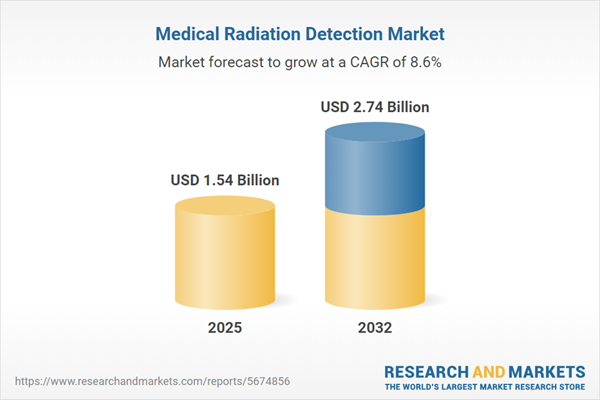Speak directly to the analyst to clarify any post sales queries you may have.
Senior decision-makers in healthcare face mounting pressures to maintain operational efficiency and regulatory compliance while managing increased safety concerns. Reliable deployment of advanced medical radiation detection technology is critical for mitigating risks, supporting quality patient care, and enabling resilient clinical environments.
Market Snapshot: Medical Radiation Detection Market Size, Trends, and Growth
The medical radiation detection market is poised for notable growth, with projections indicating an increase from USD 1.54 billion in 2025 to USD 2.74 billion by 2032, at a compound annual growth rate (CAGR) of 8.61%. This upward trajectory is supported by stricter regulatory standards and growing investments in detection solutions. Industry-wide integration of digital platforms is transforming healthcare operations, driving innovation in how providers automate processes, ensure compliance, and adapt to fast-evolving clinical requirements. Current detection technologies enable real-time risk assessment and foster operational resilience, resulting in better patient outcomes across hospitals, clinics, and research facilities.
Scope & Segmentation of the Medical Radiation Detection Market
- Product Types: Area monitors, contamination monitors, and personal dosimeters—such as electronic, film badge, and thermoluminescent variants—deliver vital protection for healthcare workers. Other devices including portal monitors, spectroscopy systems, and survey meters provide extended detection of gamma, neutron, and X-ray exposure, fulfilling rigorous safety needs in diverse healthcare operations.
- Technologies: Gas-filled detectors are offered in portable or stationary models, offering versatility for immediate or continuous monitoring. Scintillation detectors, using material such as cesium iodide and sodium iodide, enable fast, responsive detection across multiple radiation types. Semiconductor detectors with silicon or germanium components enhance data precision, fostering reliable compliance outcomes in complex clinical workflows.
- Applications: Radiation detection devices support critical imaging modalities, including CT, X-ray, mammography, and fluoroscopy, alongside core roles in radiation therapy, radiopharmacy, and advanced imaging like PET and SPECT. This breadth allows healthcare organizations to actively monitor controlled dosing and uphold patient safety standards.
- End Users: Diagnostic centers, hospitals, specialty clinics, nuclear medical establishments, pharmaceutical manufacturers, and research entities each rely on detection solutions tailored to their operational and compliance priorities, helping standardize safety practices and meet specific mandates.
- Portability: Permanent, mobile, and handheld options allow organizations to seamlessly integrate detection solutions into clinical or laboratory workflows, supporting both large-scale deployment and targeted, on-site risk mitigation strategies.
- Regions: The Americas, Europe, Middle East and Africa, and Asia-Pacific emerge as central drivers of market activity. Regional differences in procurement patterns and regulatory oversight shape the adoption of state-of-the-art and legacy detection systems alike.
- Key Players: Leading organizations, including General Electric Company, Siemens Healthineers AG, Royal Philips NV, Canon Medical Systems Corporation, Hitachi Ltd., Fujifilm Holdings Corporation, Shimadzu Corporation, Mirion Technologies Inc., and PerkinElmer Inc., are pivotal in setting sector standards and advancing detection capabilities through research and cooperation.
Key Takeaways for Senior Decision-Makers
- Platform-based detection solutions help clinical teams optimize safety protocols and compliance procedures, enabling healthcare organizations to respond quickly to dynamic regulatory frameworks.
- Cloud-driven analytics consolidate data and facilitate real-time alerts, providing actionable insights for quality assurance and improved safety interventions across care settings.
- Modular and flexible devices enable incremental hardware upgrades, allowing facilities to modernize detection infrastructure while maintaining compatibility with existing systems.
- Collaboration across providers, vendors, and regulators speeds adoption of new technologies, strengthening the pathway for innovative clinical safety practices.
- Flexible technology ecosystems improve organizational readiness for ongoing regulatory change, limiting workflow disruptions and supporting efficiency during transitions.
- Comprehensive management of device lifecycles strengthens team alignment and streamlines diagnostic and therapeutic workflows, enhancing reliable care delivery.
Tariff Impact: Navigating US Tariffs and Supply Chain Shifts
- Changes in US tariffs are leading to increased domestic manufacturing and assembly of detection equipment, which enhances the supply reliability for critical healthcare technologies.
- Advanced asset tracking and modular system design mitigate risk from supply chain volatility, ensuring sustained operations during periods of sourcing or distribution uncertainty.
- Collaborative relationships with regional parts suppliers shorten delivery timelines and provide detection solutions attuned to local compliance requirements, supporting organizational agility.
Methodology & Data Sources
This analysis draws from direct interviews with radiation safety professionals, biomedical engineers, and healthcare procurement leaders. Findings are cross-validated with peer-reviewed scientific articles, relevant regulatory publications, and patent analytics, ensuring robust and practical recommendations for organizational planning.
Why This Report Matters
- Empowers procurement and compliance teams to assess and select the most appropriate medical radiation detection systems in line with organizational goals and evolving regulatory expectations.
- Provides executive leadership with strategic insights for anticipating sector change, mitigating new risks, and building a more agile supply chain roadmap.
- Supports long-term technology planning so organizations can overcome emerging healthcare delivery challenges and make the most of future growth opportunities.
Conclusion
This report gives healthcare leadership the clarity to strengthen compliance, drive informed procurement, and advance radiation detection capabilities for safer, more effective clinical operations.
Additional Product Information:
- Purchase of this report includes 1 year online access with quarterly updates.
- This report can be updated on request. Please contact our Customer Experience team using the Ask a Question widget on our website.
Table of Contents
3. Executive Summary
4. Market Overview
7. Cumulative Impact of Artificial Intelligence 2025
Companies Mentioned
The companies profiled in this Medical Radiation Detection market report include:- General Electric Company
- Siemens Healthineers AG
- Royal Philips NV
- Canon Medical Systems Corporation
- Hitachi, Ltd.
- Fujifilm Holdings Corporation
- Shimadzu Corporation
- Mirion Technologies Inc.
- PerkinElmer, Inc.
Table Information
| Report Attribute | Details |
|---|---|
| No. of Pages | 185 |
| Published | October 2025 |
| Forecast Period | 2025 - 2032 |
| Estimated Market Value ( USD | $ 1.54 Billion |
| Forecasted Market Value ( USD | $ 2.74 Billion |
| Compound Annual Growth Rate | 8.6% |
| Regions Covered | Global |
| No. of Companies Mentioned | 10 |









